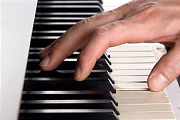
Home > Advanced Piano Lessons > Complex Rhythm
|
||||
Complex Rhythm in Piano Playing
First, it is important that players can read time signatures and rhythm notations. At a glance, they should be able to clearly discern between 4/4, 6/8, 3/4, 12/8, 6/4, and other time signatures. Having an automatic metronome pounding out the beat in your head helps make sense of the notes’ time values in each measure. The second important automatic skill – knowing notes’ timing values – comes with practice and familiarity with the way notes’ values interact with one another and with the larger time signature. Just like a novice chess player can never beat a master without years of study and experience, the same is true with playing complex rhythms on piano. First, master the basics, and then the complexities that come later won’t seem so complex. Another essential component of learning rhythm may come as a surprise – you need to master as many chords as possible. Now, this might at first seem as necessary as learning to do pull-ups so you can run faster, but the two have more in common than it first appears. Think about it – if you know chords, then you don’t have to focus on reading every single note that you see on a page. Instead, your fingers will automatically go to that familiar chord pattern that you’ve practiced so many times, and that frees your eyes and your mind to focus on the rhythm of the passage before moving onto intermediate piano lessons. Another added skill to focus on to master complex rhythms is to closely study – both with your head and your ears – the specific rhythms structures in various styles of music. Of course, you want to particularly study the rhythm of the style of music you’re interested in performing, but attention to all forms of music help build your overall knowledge base and give you much more information to compare certain rhythms to one another. It would be like visiting a foreign country to learn more about your own culture. Music comes in a multitude of styles – jazz, folk, rock, classical, Spanish, Italian, Russian, and on and on. Becoming intimately familiar with a wide variety of rhythm styles – both with your fingers and with your ears – will allow you to discern complex rhythms in piano playing very quickly.
http://pianoplayerworld.com/PianoPlayingTips.html
| ||||
|
Although every attempt has been made to make information as accurate as possible, we are not responsible for any errors that may appear.
 Complex rhythms can actually be rather easy to learn, but a piano player must
master the
Complex rhythms can actually be rather easy to learn, but a piano player must
master the 



